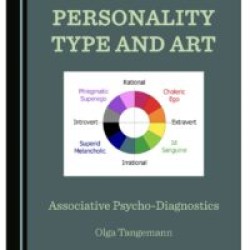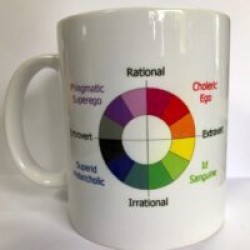Dear Readers,
In this article, I would like to shed light upon the main stages of categorization according to the “Associative Psychodiagnostics (APD)” method. Associative methodology of categorization consist of two main stages:
1.Determining the TPE profile
2.Determining the functional profile
1. Determining of the TPE profile
Understanding an individual’s psychodynamics commences with determining his psychodynamic profile, that is determining the leading and the compensatory types of psychic energy (TPE). An Association Test / Survey is appropriate for this purpose. The associative model Butterfly expounds on four kinds of psychological energy, that correspond to the four components of personality structure: Ego, Superego, Id, and Superid. Four TPEs form six variations of different combinations, that is TPE profiles. Resolving one’s psychodynamic profile not only leads to identifying the leading and the compensatory TPE, but also enables to construct a string consisting of 4 TPEs, with the least expressed one being clearly marked.
The names of the TPEs and components of personality structure coincide with the names of the partitions in the socionical Model A and go hand in hand with Sigmund Freud’s and Carl Jung’s theories of personality structure. A more elaborative article, entitled “Butterfly information-energy model,” describing the connection between psychoanalytical theories and the associative model can be accessed by clicking here
Each and every of the four TPEs corresponds to the equivalent cluster of 4 psychological types (psychotypes hereinafter). While the leading TPE links to the cluster containing the psychotype, the compensatory TPE links to the cluster containing the subtype. Let us now address the question of determining the TPE profile in a little bit more detail. Evidence for the particular TPE profile can be found in the individual’s musical tastes, color preferences, art and design predilections, that all lie in the fuzzy area separating the conscious and the unconscious. Color preferences are expressed in the Butterfly model’s socionical functions and partitions. Every partition in the model addresses a set of two functions, which identifies the key characteristics of and differences between the four psychotype clusters.
Thus, for example, rational extroverts can be told apart from the other three clusters, on the grounds of the two extroverted functions being present and exerting a dominant influence on their consciousness, namely extroverted logic Te and extroverted emotion Fe. It is thanks to these functions that the types of this particular cluster possess leadership qualities correlative with the TPE conception of Ego. Psychological functions and personality characteristics therefrom derived correspond to the sets of two polar traits, also known as dichotomies.
Only three dichotomies are relevant for determining the TPE. These dichotomies are considered the basics of the associative socionics theory, rationality – irrationality, extroversion – introversion, and statics – dynamics. When we talk of a rational, introverted, static type, the same is true for both the corresponding functions of theoretical logic Ti and relationship ethics Fi, and for the Superego TPE and the type cluster known as the Superego cluster.
Dichotomic traits are exhibited not only in music, art, design and architecture, and household articles. What is really important to take note of, is that both the TPE and the TPE profile have a superposing impact on mental ideas and conceptions, psychological states and situations.
The foundations of analyzing and interpreting a wide range of events from the psychological energy stance were laid by Sigmund Freud and Carl Jung, despite the fact that their theories covered only the person’s inner world. Associative approach took the scope of psychoanalysis and socionics beyond the boundaries of the person’s inner world, since the criteria and traits which allow us to establish a particular TPE membership are distinguishable not only in relation to the individual, but also in the world around him (fruits of a person’s particular activity, music, works of art and the natural world). To find out more about correlations between the TPEs and people’s personal characters, psychological meanings of different colors as well as how various TPEs might be expressed in music, access the article entitled “Associative typology” here
Potentially, any object or life event can be identified with a particular TPE, based on their constituent traits. This is the new universal language of uncovering the psychodynamics of a wide range of events, useful for analyzing, psycho-diagnostics, and remedying different events from the perspective of the absence or presence of energy balance.
2. Determining the Functional Profile
Now that the TPE profile is determined, we are through the first stage of associative psycho-diagnostics. Followed by a second stage of determination of the functional profile of the individual. At the functions level, we are primarily concerned with the relationship between Jung’s functions: thinking, feeling, sensation, and intuition. Then Jung’s functions are dissected according to the extroversion – introversion dichotomy and are analyzed from a more detailed perspective of the eight socionical functions of different versions. The Aspect test is administered for the purposes of the functional profile analysis. At the heart of the Aspect test lie the “dichotomies” or the “traits” approach, the knowledge of the principles behind expression of functions in accordance with Model A, and the procedure of determining the psychotype based on the club interests (scientists/researchers, socialists, humanists, managers/pragamtics).
When analyzing an individual’s answers to the questions on the Aspect test, the diagnostician first looks for consistencies and discrepancies. Then, proceeding from the discrepancies, the diagnostician sets up her conversation with the client in such a way, so as to shed light on the actual state of affairs and to establish what polar trait of the individual’s functional profile is dominant. In associative methodology, a client’s functional profile can also be established by means of a socionical dichotomies questionnaire, to include the determining of the most sensitive function survey and the self-classification survey.
3. Conclusion about types and subtypes
The values taken by the TPE and functional profiles are a necessary requirement, which, if satisfied, will suffice for the purposes of making an inference as to the individual’s psychotype and subtype in line with associative model of personality.
The views held by the subject as to his / her own psychotype are requested by the diagnostician, before the appropriate psycho-diagnostics’ techniques are administered and are taken into account along with other evidence arising from his / her scores on associative tests and other assessments. This data is given a thorough scrutiny in the process of profiling and diagnosing the underlying reasons of possible psychological problems.
A client is recommended to take associative tests at least three times at different time periods. A diagnostician is expected to be able to interpret the resultant table of associative test scores, to detect congruencies and discrepancies in the client’s answers, to point to the discrepancies, and to be able to autonomously arrive at an inference as to the probability of a certain type and subtype, that best characterizes that particular client.
4. Application of APD in psychotherapy
I will address this question separately later, since it lies beyond the boundaries of determining the socionical type and subtype. The knowledge of how APD can be applied to resolve certain psychological issues may be useful not only to psychology graduates, but also to a wide group of readers for the sake of obtaining a deeper understanding of the self and improving one’s own psychophysical condition.










1 Response
[…] Ид или Суперэго. Данный принцип положен в основу ассоциативной психодиагностики (АПД) типа личности как по вербальным так и по […]